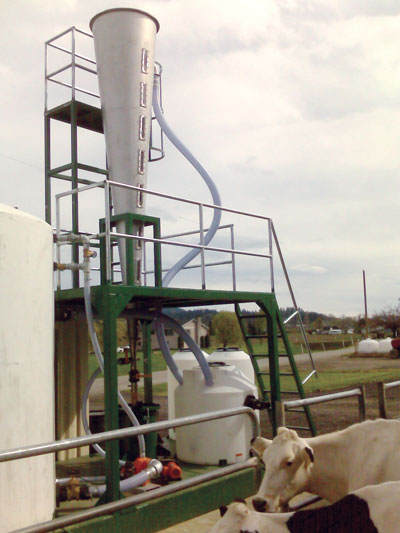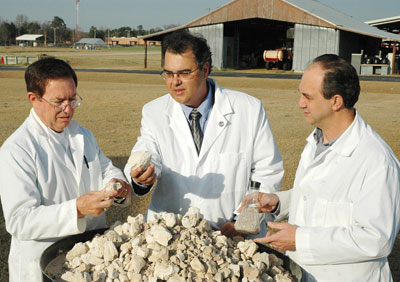
Features
Fertilizer
Seed & Chemical
Phosphate extracted from manure could fertilize crops, cut pollution
Phosphorus fertilizer has tripled in price at the same time as pollution from fertilizer and manure nutrients, particularly phosphorus, has become an increasing concern, especially in areas of highly concentrated livestock operations.
March 17, 2009 By Helen McMenamin
Phosphorus fertilizer has tripled in price at the same time as pollution from fertilizer and manure nutrients, particularly phosphorus, has become an increasing concern, especially in areas of highly concentrated livestock operations. Scientists are developing systems that address both problems by removing nutrients from manure and concentrating them into more easily transported and handled forms.

|
|
| Struvite removal system at a dairy in Washington State. Photo courtesy Keith Bowers, Multiform Harvest. |
Keith Bowers of Multiform Harvest in Seattle has developed a system to remove phosphates from swine and dairy manure. It involves changing the chemistry of the liquid manure to form struvite, a phosphate compound that is precipitated out of the slurry. Struvite, magnesium ammonium phosphate, is sometimes deposited naturally as scale on wastewater pipes and in the human body as kidney stones. It’s in demand as a slow release fertilizer and magnesium source.
It takes a relatively minor shift in chemistry to deposit struvite out of liquid manure, but it is a challenge to ensure it is deposited in particles of a size that can be separated from the liquid.
Bowers has achieved this by treating liquid manure in a fluidized bed – particles that swirl as liquid is run through them from below. The granules are buoyed up from below by the liquid, but the system is designed to prevent the liquid carrying them out of the vessel. “We use a bed of struvite granules and pump slurry in at the bottom,” says Bowers, “The struvite granules, though buoyed by the slurry, remain in the lower part of the cone, much like oil and water."
The chemical treatment is customized to match the water chemistry of each farm, adding a magnesium salt and/or raising the pH. With the correct treatment, liquid only needs to remain in the fluidized bed for one to five minutes, making equipment costs relatively low.
Up to 85 percent of the phosphate in manure can be removed as struvite, bringing the ratio of nitrogen and phosphorus much closer to crop needs and lowering pollution risks from its application.
A 1000-cow dairy where Bowers has operated test systems for some years uses a cone 15 feet high and 30 inches in diameter. His target is a cost of around 15 cents a day per cow, with two-thirds of that being for chemicals. Each day the system produces 100 to 150 lbs of struvite. “It’s not sufficiently valuable to justify setting up a processing system,” says Bowers. “But it can produce a revenue stream to offset manure treatment costs.”
USDA system removes majority of nutrients
USDA-Agricultural Research Services scientists in Florence, South Carolina, have developed a different treatment system that removes 99 percent of odour-causing chemicals and over 90 percent of dissolved nitrogen compounds as well as phosphates from hog manure. It also cuts annual greenhouse gas emissions from a 4400-head barn from almost 5000 tons of CO2 equivalents to 48 tons.
 |
|
| USDA-ARS Soil scientists Patrick Hunt (left), Mattias Vanotti (centre), and Ariel Szogi examine a sample of calcium phosphate produced by the wastewater treatment system. Photo courtesy by Maria Cruz Garcia, USDA. |
The process developed by Ariel Szogi, Mattias Vanotti and Patrick Hunt starts with separation of solids out of the manure slurry by flocculation, or clumping, with polyacrylamide. The polymer, which swells in water and is used as a soil conditioner, removes some of the nitrogen and phosphorus as well as trace nutrients such as zinc and copper along with the organic matter. The solids can be composted for soil amendment or used as biofuels.
Ammonium that remains in manure liquids are not conserved, but removed as nitrogen gas, using biological denitrification, reversing the nitrogen fixation that occurs in soil. Liquid circulates between an anaerobic and an aerobic tank where bacteria transform nitrogen compounds to harmless nitrogen gas, which is released to the atmosphere.
The remaining liquid is then transferred to a settling tank where lime is added to precipitate phosphorus as calcium phosphate, which settles to the bottom. The treatment raises the pH and eliminates fecal coliform bacteria from the treated water. The calcium phosphate is dried in dewatering bags, geotextile materials that filter out water. Although the calcium phosphate has a lower phosphate content than 11-52, fertilizer trials show it has potential as a fertilizer.
The reclaimed water, which contains low levels of nutrients, can be used for irrigation or recycled into the barn. Replacing slurry in the barn pits with treated water improved air quality to such an extent that mortality among
the pigs dropped 57 percent and daily gain and feed efficiency improved dramatically.
The system has been approved as an environmentally superior technology (EST) for waste management required under North Carolina’s hog farm regulations. This involved meeting strict standards, substantially removing nutrients, heavy metals, ammonia emissions, odours and pathogens. ARS scientists designed a full-scale demonstration project, then evaluated its performance over two years. The private company that built that project, Super Soil Systems USA of Clinton, North Carolina, is marketing the treatment system as an automated commercial system for hog farms. The cost is around $7 per finished pig. “Overall, the results show cleaner alternative technologies can have significant positive effects on livestock production and the environment,” says Szogi.
Ross McKenzie, agronomy research scientist with Alberta Agriculture, suggests nutrient extraction from manure highlights the value of manure. However, given the large western Canadian land base, applying raw or composted manure is more cost-effective. “In Western Canada at present, it’s difficult to justify the cost of an industrial system to extract nutrients from manure, “ he says. “With our vast land base, application of manure or composted manure is cost effective. I would simply recommend applying manure to a quarter of your cropland each year at a rate that provides enough P for crop production for four years. This would eliminate the need for commercial phosphate fertilizer and be very cost effective, especially with today’s fertilizer prices.”
Manure used as fertilizer releases about 25 to 50 percent of its nitrogen content and 50 to 90 percent of phosphorus and almost all the potassium in the year of application depending on the form of manure, how it’s handled, stored and applied.